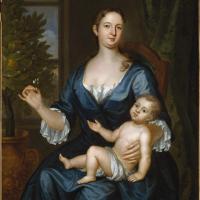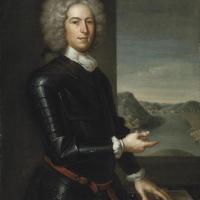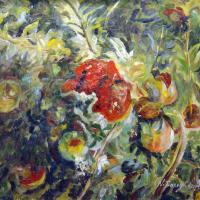John Singer Sargent
Francis Brinley John Smibert
$480.00
John Singer Sargent
John Singer Sargent (1856-1925)
John Singer Sargent (January 12, 1856 – April 14, 1925) was an American expatriate artist, considered the "leading portrait painter of his generation" for his evocations of Edwardian-era luxury. He created roughly 900 oil paintings and more than 2,000 watercolors, as well as countless sketches and charcoal drawings. His oeuvre documents worldwide travel, from Venice to the Tyrol, Corfu, the Middle East, Montana, Maine, and Florida.
He was born in Florence to American parents, and trained in Paris before moving to London, living most of his life in Europe. He enjoyed international acclaim as a portrait painter, although not without controversy and some critical reservation; an early submission to the Paris Salon, his Portrait of Madame X, was intended to consolidate his position as a society painter, but instead resulted in scandal. From the beginning his work is characterized by remarkable technical facility, particularly in his ability to draw with a brush, which in later years inspired admiration as well as criticism for a supposed superficiality. His commissioned works were consistent with the grand mannerof portraiture, while his informal studies and landscape paintings displayed a familiarity with Impressionism. In later life Sargent expressed ambivalence about the restrictions of formal portrait work, and devoted much of his energy to mural painting and working en plein air. Art historians generally ignored "society" artists such as Sargent until the late 20th century.
In the early 1880s Sargent regularly exhibited portraits at the Salon, and these were mostly full-length portrayals of women, such as Madame Edouard Pailleron (1880) (done en plein-air) and Madame Ramón Subercaseaux (1881). He continued to receive positive critical notice.
Sargent's best portraits reveal the individuality and personality of the sitters; his most ardent admirers think he is matched in this only by Velázquez, who was one of Sargent's great influences. The Spanish master's spell is apparent in Sargent's The Daughters of Edward Darley Boit, 1882, a haunting interior that echoes Velázquez's Las Meninas. As in many of his early portraits, Sargent confidently tries different approaches with each new challenge, here employing both unusual composition and lighting to striking effect. One of his most widely exhibited and best loved works of the 1880s was The Lady with the Rose (1882), a portrait of Charlotte Burckhardt, a close friend and possible romantic attachment.
His most controversial work, Portrait of Madame X (Madame Pierre Gautreau) (1884) is now considered one of his best works, and was the artist's personal favorite; he stated in 1915, "I suppose it is the best thing I have done." When unveiled in Paris at the 1884 Salon, it aroused such a negative reaction that it likely prompted Sargent's move to London. Sargent's self-confidence had led him to attempt a risque experiment in portraiture—but this time it unexpectedly back-fired. The painting was not commissioned by her and he pursued her for the opportunity, quite unlike most of his portrait work where clients sought him out.
It took well over a year to complete the painting. The first version of the portrait of Madame Gautreau, with the famously plunging neckline, white-powdered skin, and arrogantly cocked head, featured an intentionally suggestive off-the-shoulder dress strap, on her right side only, which made the overall effect more daring and sensual. Sargent repainted the strap to its expected over-the-shoulder position to try to dampen the furor, but the damage had been done. French commissions dried up and he told his friend Edmund Gosse in 1885 that he contemplated giving up painting for music or business.
Prior to the Madame X scandal of 1884, Sargent had painted exotic beauties such as Rosina Ferrara of Capri, and the Spanish expatriate model Carmela Bertagna, but the earlier pictures had not been intended for broad public reception. Sargent kept the painting prominently displayed in his London studio until he sold it to the Metropolitan Museum of Art in 1916 after moving to the United States, and a few months after Gautreau's death.
Before arriving in England, Sargent began sending paintings for exhibition at the Royal Academy. These included the portraits of Dr. Pozzi at Home (1881), a flamboyant essay in red and his first full-length male portrait, and the more traditional Mrs. Henry White (1883). The ensuing portrait commissions encouraged Sargent to complete his move to London in 1886. Notwithstanding the Madame X scandal, he had considered moving to London as early as 1882; he had been urged to do so repeatedly by his new friend, the novelist Henry James. In retrospect his transfer to London may be seen to have been inevitable.
English critics were not warm at first, faulting Sargent for his "clever" "Frenchified" handling of paint. One reviewer seeing his portrait of Mrs. Henry White described his technique as "hard" and "almost metallic" with "no taste in expression, air, or modeling." With help from Mrs. White, however, Sargent soon gained the admiration of English patrons and critics. Henry James also gave the artist "a push to the best of my ability."
Sargent spent much time painting outdoors in the English countryside when not in his studio. On a visit to Monet at Giverny in 1885, Sargent painted one of his most Impressionistic portraits, of Monet at work painting outdoors with his new bride nearby. Sargent is usually not thought of as an Impressionist painter, but he sometimes used impressionistic techniques to great effect. His Claude Monet Painting at the Edge of a Wood is rendered in his own version of the impressionist style. In the 1880s, he attended the Impressionist exhibitions and he began to paint outdoors in the plein-air manner after that visit to Monet. Sargent purchased four Monet works for his personal collection during that time.
Sargent was similarly inspired to do a portrait of his artist friend Paul César Helleu, also painting outdoors with his wife by his side. A photograph very similar to the painting suggests that Sargent occasionally used photography as an aid to composition. Through Helleu, Sargent met and painted the famed French sculptor Auguste Rodin in 1884, a rather somber portrait reminiscent of works by Thomas Eakins. Although the British critics classified Sargent in the Impressionist camp, the French Impressionists thought otherwise. As Monet later stated, "He is not an Impressionist in the sense that we use the word, he is too much under the influence of Carolus-Duran."






